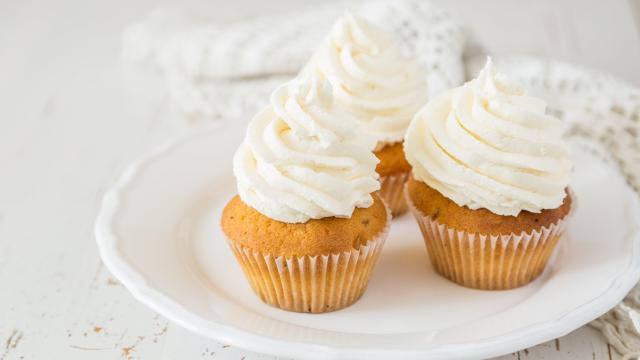It might look like fluff, but buttercream frostings are delicate emulsions. When chilly temperatures interfere with this fine balance, buttercream can break. The “break” could refer to the state of the emulsion or to your heart, because the look of broken buttercream is, oh, so sad (and gross). Luckily, fixing a broken buttercream can be simple.
Buttercream most commonly breaks during the initial mix, or while reheating frosting you had stored in the fridge or freezer. When it happens, you’ll know. Best case scenario, it will look mealy, greasy, or watery. Some call this “split.” At its worst, it will have hundreds of white chunks surfing around in a clear, syrupy liquid. This happens most commonly with marshmallowy meringue buttercream, rendering it decidedly un-marshmallowy. It’s not pretty. The buttercream isn’t fully emulsified and, barring a mistake in the recipe, the butter is your problem and solution.
You need to heat up that butter, along with the rest of the mixture. Those of us who, in our delirium, have reached down to poke at broken buttercream have felt that the white clumps are firm, maybe even hard. This indicates that fats are cold and have separated from the rest of the mixture. In order to have a soft, spreadable frosting, your main ingredient needs to be soft and spreadable. That means warm-ish butter. This could be an “I told you so” moment for the room-temperature-ingredients-crew, but broken buttercream can happen even if you started with softened butter. Forgive yourself. It’s easy to fix. You just need to bring the frosting up to temperature. The following methods can fix a stubborn frosting that refuses to emulsify, and quickly reheat a frosting you had stored in the fridge to a spreadable consistency.
Use flames
The most fun way to heat up the frosting is with a blowtorch. This only works if your mixer has a metal bowl. Do not do this with a glass bowl. Turn on the mixer with the broken frosting, and run the torch’s flame along the bottom and sides of the bowl while it mixes. Stop every 10-20 seconds or so (depending on the size and power of your torch it might be less time). The mixture against the metal will melt. Let the hot stuff blend in, and it will begin to take the rest of the mixture up to temperature. The broken globules of fat will become fewer, and larger, until it is one homogenous mixture. Alternatively, you can take the metal bowl and hold it over the flame of a gas burner for a few seconds to melt some of the mixture. Return it to the mixer to blend.
Melt some in the microwave
Not everyone has a torch stashed in their kitchen, but odds are good that you have a microwave. Remove about a cup of the broken frosting and put it in a microwave safe measuring cup. Heat up the frosting in the microwave until melted, this won’t take long, maybe 15-20 seconds. Pour the hot, melted frosting back into the rest of the batch, and mix until fluffy. This can be repeated if needed.
Mix and wait
Although it can take a while, you can set your mixer on and walk away. No flames required. Set your mixer speed to high or medium, but I usually go with the fastest speed the frosting can handle without flying out of the bowl. (Slower speeds will take a little longer to warm up.) The buttercream will eventually come up to room temperature no matter what, and the mixer will help expedite this. The caveat is that emulsification won’t happen if your ambient temperature is below 18°C degrees (the lowest temperature for softened butter). If the weather is chilly, try one of the other two methods, and you’ll be ready to frost a cake in no time.

Leave a Reply
You must be logged in to post a comment.